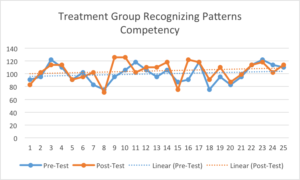 Can a 10-week EQ Course change the Emotional Intelligence scores of students in a rural Appalachian high school class?
Can a 10-week EQ Course change the Emotional Intelligence scores of students in a rural Appalachian high school class?
Eastern Kentucky is comprised of tiny towns tucked into valleys between the steep Appalachian Mountains in the heart of coal country. The region has some of the highest drop-out rates in the nation, as well as a high proportion of families living in deep poverty. Children grow up aware of media stereotypes depicting them as uneducated “hillbillies”. Despite these challenges, there is a strong culture that values close family and community connections and traditions. It is in this learning environment that Dr. Michael C. Melton, with assistance from a Six Seconds grant, conducted his doctoral research into emotional intelligence (EQ) at a local high school.
Does EQ instruction by a skilled educator have the potential to change a student’s world view? Here’s one student’s response to Dr. Melton.
“Something you said in one of the classes stuck with me. You said, ‘I want you to be able to see how the world sees you.’ That has really made a difference in how I act at school and at home. I try to think before I say or do anything.”
 The high school students in Eastern Kentucky attended an EQ class as part of a Case Study conducted by Dr. Michael C. Melton for his Morehead State University dissertation. They expressed powerful reactions to their experiences.
The high school students in Eastern Kentucky attended an EQ class as part of a Case Study conducted by Dr. Michael C. Melton for his Morehead State University dissertation. They expressed powerful reactions to their experiences.
“I didn’t realize how my behavior truly affected how I was treated until I tried to think about how I was acting and reacting to others.”
 In this mixed methods case study, conducted in the short time frame of 10 weeks, Dr, Melton evaluated the effect of teaching emotional intelligence on high school students’ EQ scores as measured by the SEI-YV, Six Seconds’ emotional intelligence assessment for youth, ages 7-18.
In this mixed methods case study, conducted in the short time frame of 10 weeks, Dr, Melton evaluated the effect of teaching emotional intelligence on high school students’ EQ scores as measured by the SEI-YV, Six Seconds’ emotional intelligence assessment for youth, ages 7-18.
The research questions below were at the core of Dr. Melton’s study.
- What effect does Emotional Intelligence instruction have on student emotional intelligence (EI) level or emotional quotient (EQ)?
- Is it possible to increase student Emotional Intelligence (EI) level or Emotional Quotient (EQ) over the course of ten weeks?
What was Dr. Melton’s research process?
Michael applied for a Six Seconds Grant and used the SEI Youth Version assessment to measure the students’ Emotional Intelligence before and after a ten-week intervention, 1 hour per lesson, based on the Self Science curriculum.
The sample consisted of 50 students, grades 9-12, divided into a Treatment group (25 students exposed to the 10 week intervention) and a Control group (25 students not exposed to the 10 week intervention).
Over the course of this ten-week training, Treatment group students were engaged in reflecting about and putting into action many of the EQ competencies in the Six Seconds model, such as naming their feelings, navigating their emotions and reactions, recognizing patterns, and using optimism to make decisions.
The Treatment group students also participated in an individual and confidential exit interview aimed to assess the value and the benefits of the intervention on Emotional Intelligence.
Results:
The results from the SEI-YV with the treatment group resulted in a finding of significance in the Know Yourself pursuit and competency of Recognizing Patterns. The total emotional intelligence (EI) score and the Enhance Emotional Literacy score, also in the Know Yourself area, both of which were close to being statistically significant.
The Control Group results did not show the emotional intelligence score or any of the pursuits or competencies to be statistically significant. This was expected as the Control Group only had familiarity with emotional intelligence just from exposure to taking the SEI-YV since they were not a part of the instructional component of the study.
Based on the interviews with Treatment group students, 64% percent of the participants expressed that the emotional intelligence instructional lessons had caused them to think more constructively about how their emotional responses effected their own emotions and that, at least occasionally, they were more aware of their own feelings.
“I’m more aware of how people see me through my behavior and what I say.”
Forty-five percent of the students answered that they were more able to make positive emotional decisions because of the EI lessons.
Thirty-one percent of participants expressed that their personal relationships had improved due to their participation in the EI lessons.
My relationship with my mom has gotten so much better since I tried some of the tips we went over in the class. I have actually tried to listen to what my mom is saying and think about why she is telling me what she is.
 One third of the students expressed being happier in their everyday lives since they had participated in the EI lessons, and 41% expressed that they planned to continue using EI strategies to improve their personal relationships.
One third of the students expressed being happier in their everyday lives since they had participated in the EI lessons, and 41% expressed that they planned to continue using EI strategies to improve their personal relationships.
“I am more aware of how I’m feeling and what are the causes of my feelings. I’m more observant of others’ feelings and try to be more aware of what maybe causing them to act the way they do.”
Forty-three percent of the Treatment Group felt that all students would benefit from EI lessons and over 31% answered that they would like to participate in more EI lessons in the future. One student wrote:
I find this to be powerful. I have always been a friendly, fun-loving person but since I have become more aware of my feelings, my relationships with adults and my friends have improved beyond my expectations. I really thought that I would not get anything out of these classes, but I did!
Discussion:
In this brief 10-week study, the data suggest that it is possible to positively impact some components of EI in a high school class in rural Kentucky. Students’ skills in self-awareness, measured by emotional literacy and recognizing patterns, improved. Some other EQ skills showed a decrease from the pre-test to post-test. How can this be explained? One hypothesis is that participants may have answered on the post-test more critically as they were more aware of the concepts of EI. Dr. Melton had personal experience in another study where his post-test EI score decreased because he answered more critically on the post-test.
Given the time limitations, it’s gratifying to see from student comments that they were, in many cases, profoundly impacted by their experience in this study. For further information on the case study, please contact Michael C. Melton [email protected]
If you are a researcher, a student, a consultant and, of course, a Six Seconds certified or Preferred Partner who would like to conduct a study using the Six Seconds tools and assessment, please apply for our Grant system HERE.
To learn more about social emotional learning, read and download our Case for EQ in Schools 2015.
- Creating Connection in Higher Education - May 29, 2018
- Research: Growing an Emotionally Intelligent School - April 17, 2018
- Studying EQ in a Rural Appalachian Highschool - June 17, 2016



Hi
I’m in South Africa and work as a psychologist in a prison. I’m very interested in conducting research related to EQ and the impact EQ courses could have on juvenile offenders. Please can you advise me re courses I could do on Six seconds that could help me in my research. I really am inspired by the study conducted by Mr Melton.
Kind regard
Renitha Sooknannan
Hi Renitha: I’m so glad that you liked Micheal’s excellent study. As you know he received a grant from Six Seconds and some support from us to conduct it. If you would like to get some feedback from us, please fill out a tentative grant application on the website: http://6seconds.org/tools/grants/ My colleague, Ilaria Boffa and I will review the grant and then contact you. At that point, we’ll be happy to speak with you, give tips on research design and which assessments to use, and make suggestions for which courses at Six Seconds you might benefit from. We have a lot of experience with supporting researchers and would be glad to talk with you. Warmly, Dr Susan Stillman, Director of Education, Global Office Six Seconds.
It truly was a gratifying experience collaborating with Dr. Stillman and Six Seconds. Their assistance was invaluable and were always available to answer my questions and concerns. The study was the most rewarding educational experience I have had in my twenty year career. Because of my experience with Six Seconds I am currently conducting a study on empathy instruction and documentaries on the oral history of the greatest generation in southeastern Kentucky and the Old Regular Baptist Church.